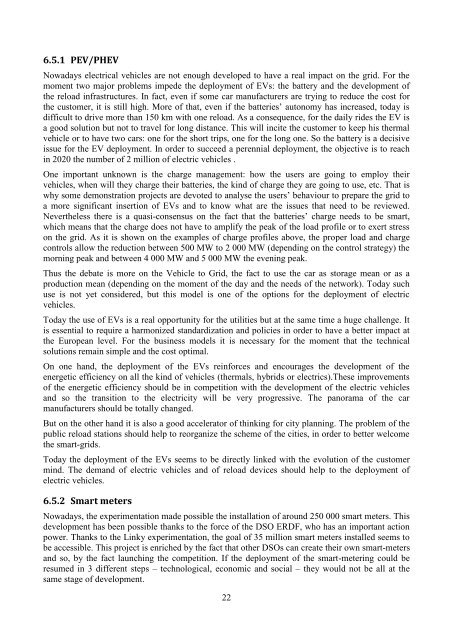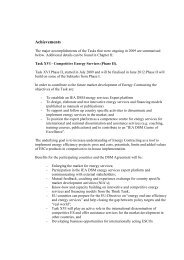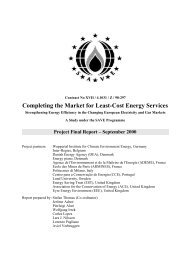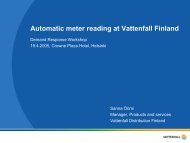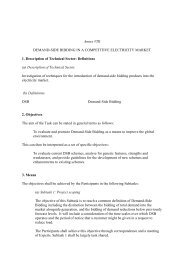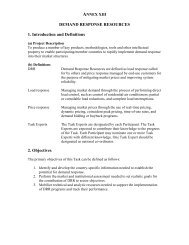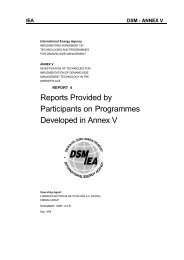Summary and conclusions - IEA Demand Side Management ...
Summary and conclusions - IEA Demand Side Management ...
Summary and conclusions - IEA Demand Side Management ...
You also want an ePaper? Increase the reach of your titles
YUMPU automatically turns print PDFs into web optimized ePapers that Google loves.
6.5.1 PEV/PHEVNowadays electrical vehicles are not enough developed to have a real impact on the grid. For themoment two major problems impede the deployment of EVs: the battery <strong>and</strong> the development ofthe reload infrastructures. In fact, even if some car manufacturers are trying to reduce the cost forthe customer, it is still high. More of that, even if the batteries’ autonomy has increased, today isdifficult to drive more than 150 km with one reload. As a consequence, for the daily rides the EV isa good solution but not to travel for long distance. This will incite the customer to keep his thermalvehicle or to have two cars: one for the short trips, one for the long one. So the battery is a decisiveissue for the EV deployment. In order to succeed a perennial deployment, the objective is to reachin 2020 the number of 2 million of electric vehicles .One important unknown is the charge management: how the users are going to employ theirvehicles, when will they charge their batteries, the kind of charge they are going to use, etc. That iswhy some demonstration projects are devoted to analyse the users’ behaviour to prepare the grid toa more significant insertion of EVs <strong>and</strong> to know what are the issues that need to be reviewed.Nevertheless there is a quasi-consensus on the fact that the batteries’ charge needs to be smart,which means that the charge does not have to amplify the peak of the load profile or to exert stresson the grid. As it is shown on the examples of charge profiles above, the proper load <strong>and</strong> chargecontrols allow the reduction between 500 MW to 2 000 MW (depending on the control strategy) themorning peak <strong>and</strong> between 4 000 MW <strong>and</strong> 5 000 MW the evening peak.Thus the debate is more on the Vehicle to Grid, the fact to use the car as storage mean or as aproduction mean (depending on the moment of the day <strong>and</strong> the needs of the network). Today suchuse is not yet considered, but this model is one of the options for the deployment of electricvehicles.Today the use of EVs is a real opportunity for the utilities but at the same time a huge challenge. Itis essential to require a harmonized st<strong>and</strong>ardization <strong>and</strong> policies in order to have a better impact atthe European level. For the business models it is necessary for the moment that the technicalsolutions remain simple <strong>and</strong> the cost optimal.On one h<strong>and</strong>, the deployment of the EVs reinforces <strong>and</strong> encourages the development of theenergetic efficiency on all the kind of vehicles (thermals, hybrids or electrics).These improvementsof the energetic efficiency should be in competition with the development of the electric vehicles<strong>and</strong> so the transition to the electricity will be very progressive. The panorama of the carmanufacturers should be totally changed.But on the other h<strong>and</strong> it is also a good accelerator of thinking for city planning. The problem of thepublic reload stations should help to reorganize the scheme of the cities, in order to better welcomethe smart-grids.Today the deployment of the EVs seems to be directly linked with the evolution of the customermind. The dem<strong>and</strong> of electric vehicles <strong>and</strong> of reload devices should help to the deployment ofelectric vehicles.6.5.2 Smart metersNowadays, the experimentation made possible the installation of around 250 000 smart meters. Thisdevelopment has been possible thanks to the force of the DSO ERDF, who has an important actionpower. Thanks to the Linky experimentation, the goal of 35 million smart meters installed seems tobe accessible. This project is enriched by the fact that other DSOs can create their own smart-meters<strong>and</strong> so, by the fact launching the competition. If the deployment of the smart-metering could beresumed in 3 different steps – technological, economic <strong>and</strong> social – they would not be all at thesame stage of development.22


